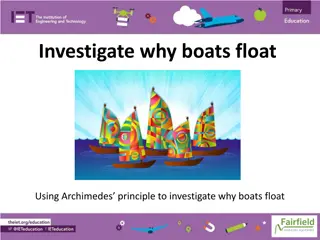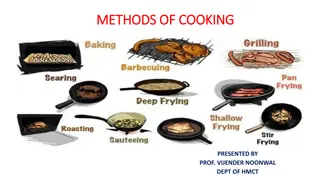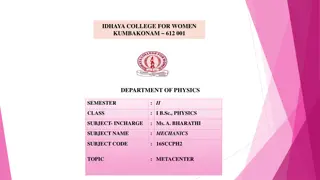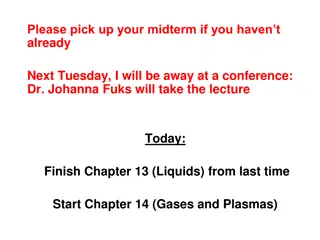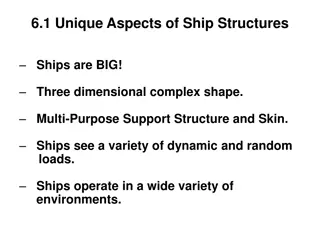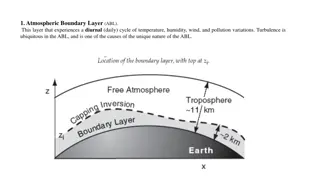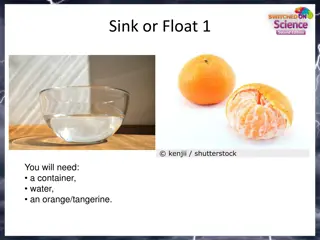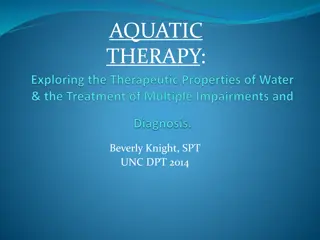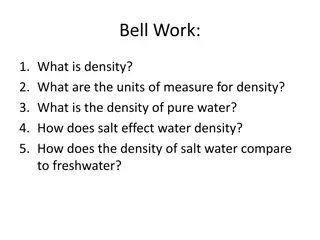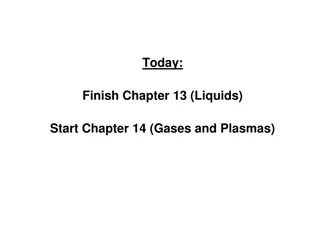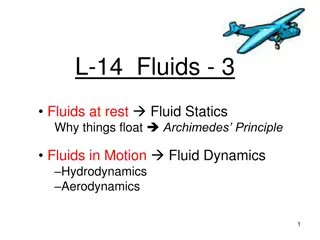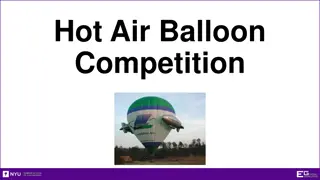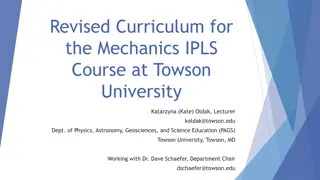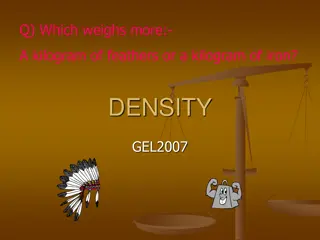Understanding Boat Floatation with Archimedes Principle
Explore the concept of why boats float using Archimedes' principle, which explains the relationship between density, volume, and buoyancy. Discover how objects sink or float based on their density relative to water, and experience a hands-on investigation to witness these principles in action.
5 views • 11 slides
Understanding Cooking Methods: Conduction and Convection Explained
Cooking methods like conduction and convection are fundamental in culinary arts. Conduction involves direct heat transfer through matter, while convection utilizes the movement of fluids for heat transfer. Gravity and buoyancy play crucial roles in natural convection processes, resulting in efficien
1 views • 45 slides
Understanding Buoyancy and Archimedes Principle
Explore the concepts of buoyancy, Archimedes principle, sink or float scenarios, and examples related to buoyant force calculations and floating objects. Learn how buoyant force determines whether objects sink or float in liquids, and understand the relationship between object density and fluid dens
0 views • 9 slides
Understanding Metacentre in Fluid Mechanics
Metacentre is a crucial concept in fluid mechanics, representing the theoretical point where a displaced body intersects lines passing through the centres of buoyancy and gravity. It is essential for analyzing the stability of floating bodies, especially ships. The metacentric height, the distance b
11 views • 15 slides
Understanding Gases and Plasmas in the Atmosphere
Delve into the concepts of gases and plasmas in the atmosphere, exploring topics such as fluid pressure, buoyancy, and the unique properties of gases compared to liquids. Discover how the balance between kinetic energy and gravity determines the thickness of our atmosphere and why it is essential fo
0 views • 25 slides
Understanding Ship Stability: Centre of Gravity and Metacentre
Exploring the concepts of transverse statical stability, centre of gravity, centre of buoyancy, metacentre, stable equilibrium, unstable equilibrium, and neutral equilibrium in ship stability. The relationship between these key points determines a ship's stability and ability to maintain a steady po
0 views • 8 slides
Understanding Fluid Statics and Atmospheric Pressure Measurements
Exploring the concept of fluid statics, this content delves into topics such as how atmospheric pressure is measured, buoyancy, and why a steel boat can float. It covers the measurement of pressure, the relationship between pressure and depth in fluids, and demonstrations showcasing these principles
0 views • 24 slides
Understanding Unique Aspects of Ship Structures
Ships have complex three-dimensional shapes and support structures to withstand dynamic loads in various environments. Structural loads such as weight and buoyancy are distributed forces that affect shear stress in ship structures. Strategies to reduce shear stress include matching buoyancy and weig
0 views • 58 slides
Understanding Atmospheric Boundary Layer and Static Stability
The Atmospheric Boundary Layer (ABL) undergoes daily variations in temperature, humidity, wind, and pollution with turbulence being a key factor. Static stability in the environment determines the behavior of air parcels, leading to categorizations of stable, unstable, and neutral conditions based o
0 views • 13 slides
Fun Science Experiments: Sink or Float Activities
Conduct two engaging sink or float experiments using items like an orange, tangerine, water, and tin foil. Learn about buoyancy, density, and the role of trapped air pockets in objects floating. Explore comparative tests and understand why objects either sink or float in water.
0 views • 6 slides
Exploring Aquatic Therapy: Benefits, Techniques, and Research Findings
Aquatic therapy, presented by Beverly Knight, SPT, offers a unique approach to rehabilitation with properties of water like buoyancy and resistance. This therapy can benefit patients with various conditions such as chronic pain, arthritis, and neurological impairments. The content covers indications
0 views • 22 slides
Understanding Water Salinity and Density
Water density is a crucial property influenced by factors like salinity and temperature. Saltwater is denser than freshwater due to dissolved substances, affecting the buoyancy of marine environments. Salinity levels vary in different bodies of water, impacting ecosystems and supporting diverse orga
0 views • 14 slides
Exploring the Fascinating World of Gases and Plasmas in Chapter 14
Delve into the intriguing realm of gases and plasmas as we transition from liquids in Chapter 13. Understand the dynamics of fluid pressure, buoyancy, and the unique characteristics that differentiate gases from liquids. Explore examples illustrating the concepts and ponder over the mysteries of our
0 views • 28 slides
Understanding Buoyancy and Floatation Principles
Buoyancy and floatation principles explained through Archimedes' principle, stability of floating bodies, and stability of submerged bodies. Learn how the upthrust force equals the weight of the displaced fluid, and how equilibrium and stability are crucial for objects to float or sink.
0 views • 6 slides
Understanding Buoyancy and Archimedes' Principle
Buoyancy is the upward force experienced by a body when immersed in a fluid, counteracting gravity. This force is determined by Archimedes' principle, which states that the buoyant force is equal to the weight of the fluid displaced. For floating bodies, the weight of the body equals the buoyant for
0 views • 4 slides
Understanding Why Objects Float or Sink in Fluids
Archimedes' principle explains the buoyancy force that causes objects to float or sink in fluids based on the weight of the displaced fluid. The buoyant force must equal the object's weight for it to float. Objects less dense than the fluid will float, while those denser will sink. Discover the scie
0 views • 22 slides
Hot Air Balloon Competition Overview
Explore the Hot Air Balloon Competition focusing on demonstrating buoyancy and thermodynamics principles through minimal design concepts. The event involves designing and constructing a balloon to maximize payload, flight time, and cost efficiency. Participants follow strict competition rules to add
0 views • 16 slides
Enhanced Mechanics IPLS Curriculum Implementation at Towson University
Towson University's Physics department, led by Lecturer Katarzyna (Kate) Oldak and Dr. Dave Schaefer, has revised the curriculum for the Mechanics IPLS Course. Changes include updated lecture schedules, lab manual enhancements, and in-class activities to aid problem-solving skills. New topics like d
0 views • 9 slides
Mastering Sales: The Art of Selling in the New World
Explore the evolution of sales from the old world to the new world, understanding the ABCs of selling, focusing on Attunement, Buoyancy, and Clarity. Dive into practical exercises to improve sales skills like role-playing and guidelines for effective customer conversations. Learn how to remain optim
0 views • 17 slides
Understanding Density and Related Concepts in Physics
Explore the concept of density and related terms such as mass, viscosity, buoyancy, volume, and more in physics. Learn how to calculate density, understand mass and volume relationships, and solve problems involving the properties of different materials. Discover the principles behind buoyancy, visc
0 views • 35 slides
Understanding Density and Mass in Science
Density is a fundamental concept in science, defined as mass per unit volume. Different substances have different densities, impacting their weight and buoyancy. By measuring mass and volume, one can calculate density and understand properties of various materials, regular and irregular solids, meta
0 views • 12 slides
